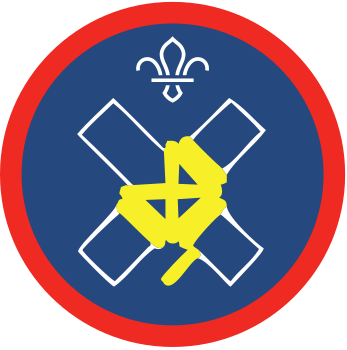Top of the table
You’ll need
- 14 lengths of rope suitable for lashing
- 5 long spars for top support, seat and tabletop
- 4 medium spars for A-frames
- 2 small spars for A-frame bases
- Planks or spars for tabletop (to fit)
Before you begin
- Before building your table, check that your ropes and spars are in good condition and not likely to break whilst the table is in use.
- Try to scale the project with those building it. Nothing should be too heavy for one person to lift and use safely.
- Make sure everyone has sturdy shoes on and that the ground you’re building your table on is steady, level and presents no other hazards.
- Use the attached assembly instructions for a visual explanation of the project.
Ready, set, pioneer!
- Start making two A-frames. Take two similar-length spars and tie a sheer lashing on one end. This will be the top of one frame.
- Pull the two spars apart at the other end. Lash a third spar across the base of the ‘A’ to make the support. Use a diagonal or square lashing.
- Make a second A-frame in the same way and check that both are the same size and shape by standing them up, side by side.
- Take five long spars, these will decide how long your table is. Lash the first one to connect the two A-frames, this will help keep your structure upright while you work on the rest.
- Using a square lashing, set a spar on either side of the A-frame at a height to work as a bench seat.
- Make sure it is joined at the same height on each A-frame so that you don’t slide down to one end whilst using the bench later!
- Lash a second spar on each side, slightly higher than the bench spars, this will be the tabletop so make sure that it sits at a comfortable height and is level.
- Take some staves or planks to make the tabletop. They will need to be long enough to reach between the two supports on each A-frame and make a level enough surface to create a usable table. To keep the tabletop in place use a simple weave like the floor lashing.
- Place your table somewhere central in your camp where it can be used by everybody and pack away any unused materials.
Reflection
This activity put your skills with lashings to the test. Getting the techniques right was the difference between dining comfortably and your dinner falling on the floor! How did you work together to make sure all of your lashings were tight enough to hold securely? This table would’ve been very difficult to build alone, without someone to hold up the A-frames and hold together the parts you were lashing. Having someone check your lashings as you went would’ve saved time too.
Pioneering isn’t about speed. It’s about building something safe and useful. You can take your time and start again if you need to. Once you’ve got your dining solution ready, you can set about solving the problem of the rumbling tummies.
Safety
All activities must be safely managed. You must complete a thorough risk assessment and take appropriate steps to reduce risk. Use the safety checklist to help you plan and risk assess your activity. Always get approval for the activity, and have suitable supervision and an InTouch process.
- Poles and long objects
Be careful when moving poles or long items. Take care if the ends are sharp. Have appropriate supervision for this activity.
- Heavy and awkward objects
Never lift or move heavy or awkward items alone. Ask for help or, if possible, break them down into smaller parts.
- Outdoor activities
You must have permission to use the location. Always check the weather forecast, and inform parents and carers of any change in venue.
- Try making a model of your table using smaller spars before starting the full scale one, so you can perfect the design and practise your lashings.
- If there’s time, you could add a useful shelf to your table. This is best situated just below the tops of your A-frames. Create this in the same way you made the table surface, and you’ll have a useful spot to put down your mug, a candle or your bird-watching binoculars!
- Make sure everyone has everything they need to complete the tasks in this activity. Pair up or have helpers lend a hand with the fiddly bits.
- It may be necessary to scale down your table to make building it and using it possible for everyone.
All Scout activities should be inclusive and accessible.
If you enjoyed this project, see what other things you could build from poles and rope. Why not have a go at a gateway, bridge or fairground ride?
Encourage young people with existing pioneering skills to support those less confident and help them develop skills and solve problems.
